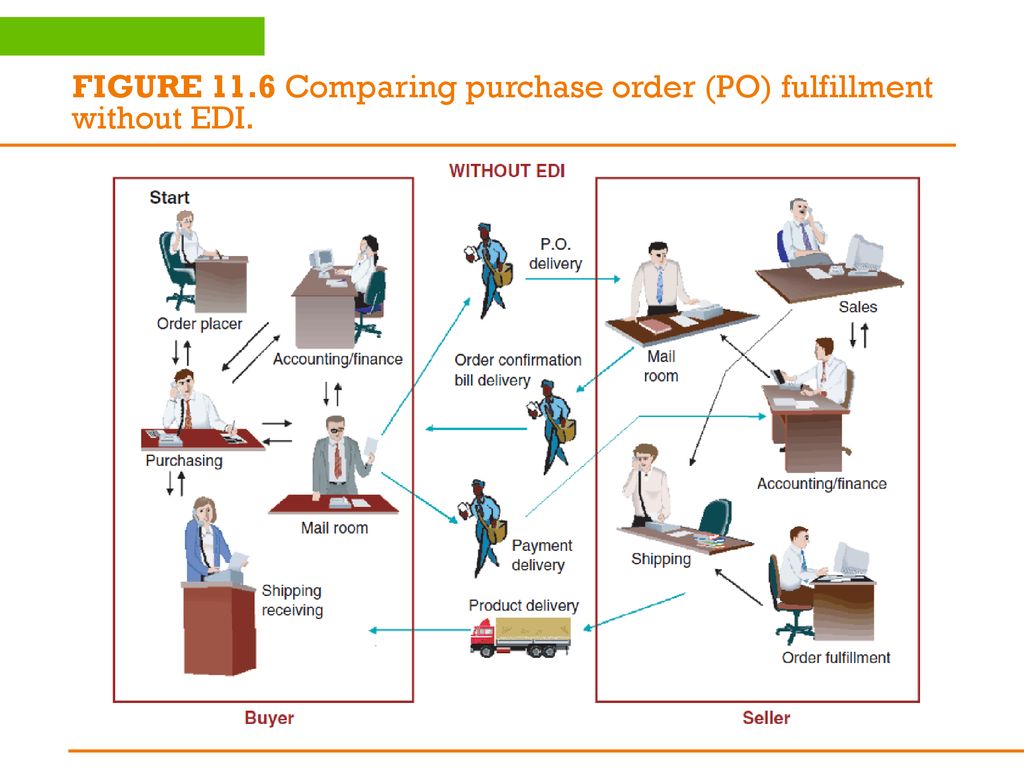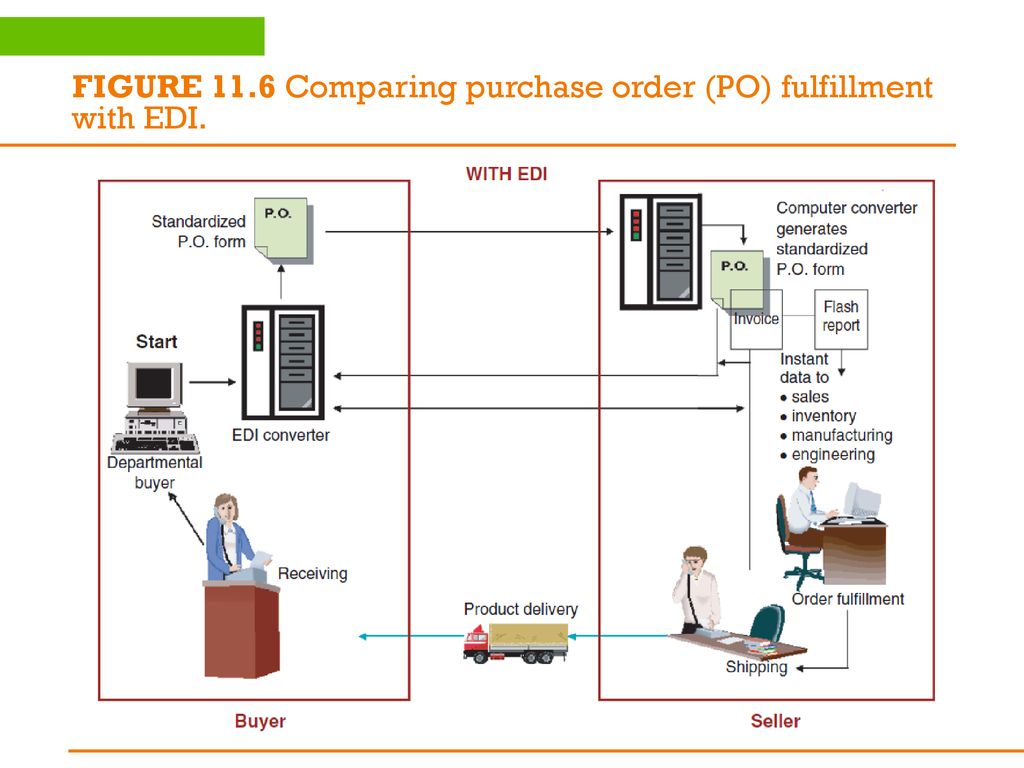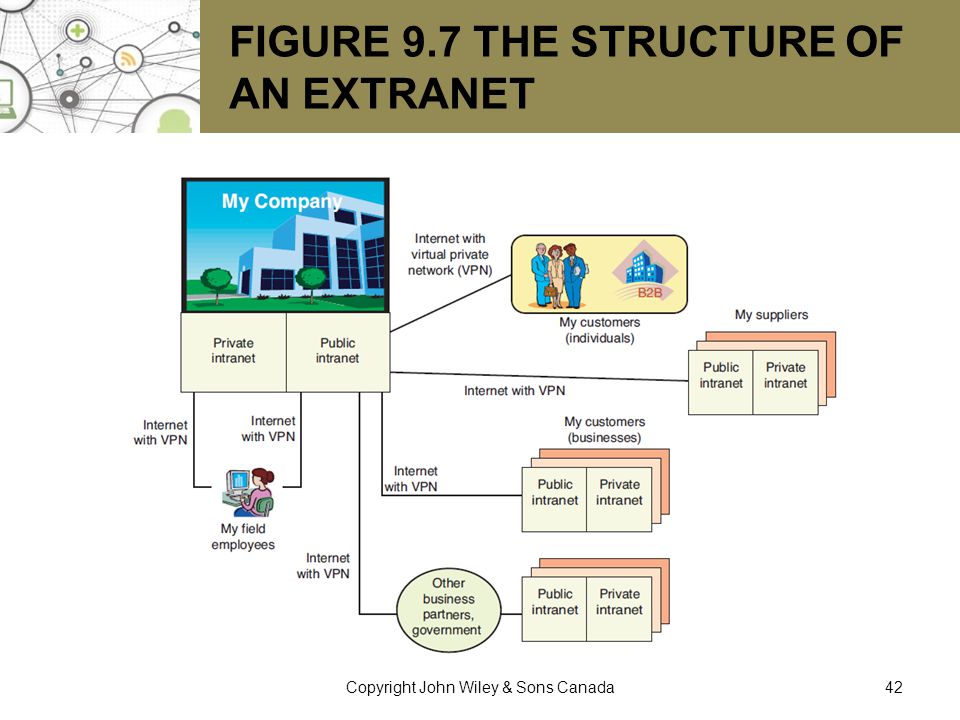Electronic Data Interchange (EDI)
Electronic Data Interchange and Information Technology Support for Supply Chain Management
Clearly, supply chain management systems (SCM)Opens in new window are essential to the successful operation of many businesses. According to the market research from GartnerOpens in new window, the major SCM software vendors include SAPOpens in new window, OracleOpens in new window, BlueYonderOpens in new window, Ariba (now part of SAP)Opens in new window, and Manhattan AssociatesOpens in new window. These systems—interorganizational systems (IOSs) in general—rely on various forms of IT to resolve problems.
Three technologies, in particular, provide support for IOSs and SCM systems: electronic data interchange, extranets, and web services.
Electronic Data Interchange (EDI)
Electronic data interchange (EDI) is a communication standard that enables business partners to exchange routine documents, such as purchasing orders, electronically. EDI formats these documents according to agreed-upon standards (for example, data formats). It then transmits messages over the Internet using a converter, called a translator.
EDI provides many benefits not available with a manual delivery system. To begin with, it minimizes data entry errors, because each entry is checked by the computer. In addition, the length of the message can be shorter, and messages are secured.
EDI also reduces cycle time, increases productivity, enhances customer service, and minimizes paper usage and storage.
The figures underneath contrast the process of fulfilling a purchase order with and without EDI.

|

|
These benefits are quick to realize when a company has a large number of suppliers, such as in the case of Baxter Canada in Example X-1.
| Example X-1 |
|---|
| Baxter CanadaOpens in new window, a subsidiary of Baxter International IncOpens in new window., manufactures a wide range of medical supplies that are used by hospitals, kidney dialysis clinics, nursing homes, rehabilitation centres, doctors’ offices, clinical and medical research laboratories, and by patients at home under physician supervision. The company sources the materials and components that it needs to manufacture these products from a large number of suppliers. In order to streamline the purchasing process among so many suppliers, Baxter CanadaOpens in new window allows them to process their purchases using electronic data interchange (EDI) technology that can be linked to the suppliers’ materials management information system or their enterprise resource planning system. Baxter CanadaOpens in new window uses EDI with its suppliers to support transactions such as invoicing, processing, payments, and sending information about prices and products. EDI does have some disadvantages. Business processesOpens in new window sometimes must be restructured to fit EDI requirements. Also, many EDI standards are in use today, so one company might have to use several standards in order to communicate with multiple business partners. In today’s world, where virtually every business has a broadband connection to the Internet and where multi-megabyte design files, product photographs, and PDF sales brochures are routinely e-mailed, the value of reducing a structured e-commerce message from a few thousand XML bytes to a few hundred EDI bytes is negligible. As a result, EDI is being replaced by XML-based web services. |
Extranets
To implement interorganizational systems (IOSs) and supply chain management (SCM) systems, a company must connect the intranets of its various business partners to create extranets.
Extranets link business partners over the Internet by providing them access to certain areas of each other’s corporate intranets (see Figure 9.7, below).

|
The primary goal of extranets is to foster collaboration between and among business partners. An extranet is open to selected B2B suppliers, customers, and other business partners.
These individuals access the extranet through the Internet. Extranets enable people located outside a company to collaborate with the company’s internal employees. An extranet also allows external business partners to enter the corporate intranet, via the Internet, to access data, place orders, check the status of those orders, communicate, and collaborate. It also enables partners to perform self-service activities such as checking inventory levels.
Extranets use virtual private network (VPN) technology to make communication over the Internet more secure. The major benefits of extranets are faster processes and information flow, improved order entry and customer service, lower costs (for example, communications, travel, and administrative overhead), and overall improved business effectiveness.
There are three major types of extranets. The type that a company chooses depends on the business partners involved and the purpose of the supply chain. Each type is presented below, along with its major business applications.
- A Company and Its Dealers, Customers, or Suppliers.
This type of extranet centres on a single company. An example is the FedEx extranet, which allows customers to track the status of a delivery. To do so, customers use the Internet to access a database on the FedEx intranetOpens in new window. By enabling a customer to check the location of a package, FedEx saves the cost of having a human operator perform that task over the phone.
Sometimes extranets are part of corporate portals. Corporate portals offer a single point of access through a web browser to critical business information in an organization. In the context of business-to-business supply chain management, these portals enable companies and their suppliers to collaborate very closely.
There are two basic types of corporate portals: procurement (sourcing) portals for a company’s suppliers (upstream in the supply chain), and distribution portals for a company’s customers (downstream in the supply chain).
|
- An Industry’s Extranet.
Just as a single company can set up an extranet, the major players in an industry can team up to create an extranet that will benefit all of them.
For example, ANXeBusinessOpens in new window enables companies to collaborate effectively through a network that provides a secure global medium for B2B information exchange.
The ANX NetworkOpens in new window is used for mission-critical business transactions by leading international organizations in aerospace, automotive, chemical, electronics, financial services, health care, logistics, manufacturing, transportation, and related industries. The network offers customers a reliable extranet and VPN services.
- Joint Ventures and Other Business Partnerships.
In this type of extranet, the partners in a joint venture use the extranet as a vehicle for communications and collaboration. An example is Bank of America’s extranet for commercial loans. The partners involved in making these loans include a lender, a loan broker, and a title company.
The extranet connects lenders, loan applicants, and the loan organizer, Bank of AmericaOpens in new window. A similar case is Lending TreeOpens in new window, a company that provides mortgage quotes and also sells mortgage on-line. Lending TreeOpens in new window uses an extranet for its business partners (for example, the lenders).
- Bechtel C, Jayaram J (1997) Supply chain management: a strategic perspective. Int J Logistics Manag 8 – 1:15 – 34.
- Ballou R (1992) Business logistics management, 3rd edn. Prentice-Hall, Upper Saddle River BCG (2010) Rethinking operations for a two-speed world, Special Report, Boston Consulting Group.
- Vonderembsea M, Uppalb M, Huange S, Dismukes J (2006) Designing supply chains: towards theory development. Int J Prod Econ 100:223–238
- Vollman T, Berry W, Whybark C, Jacobs R (2005) Manufacturing planning and control systems for supply chain management, 5th edn. McGraw-Hill, New York.

